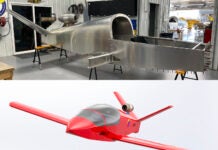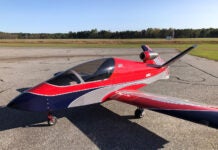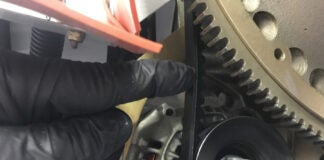
This day was a long time coming for me. Flying my own jet!
This couldn’t have been possible without the help and expertise of the Jet Guys. They don’t understand the word impossible. If someone tells them it can’t be done, they just laugh, and then they do it. This project was not without its setbacks and failures, but all that just makes this moment that much sweeter. 272 times sweeter! Again, my thanks to Robert, Mike, Steve, and Terry, the Jet Guys, that makes the impossible… possible!
–John Albritton, Oakland, Tennessee
The Jet Guys go on to describe the project:
We were given a rare opportunity with the construction of John’s jet. The only pre-conceived plan for the construction was he would have a jet engine in it. Otherwise the designing was left up to the discretion of Robert. Robert would then supervise John’s building to conform with the required design parameters. Here’s an example:
With the air intakes in the location desired, bends in the intake ducting had too great a bend in them to retain the airflow efficiency into the engine necessary to extract all the available performance from the engine. The only viable solution was to run them into the back seat. This renders the jet to single seat. John was ok with this. Why? Good question. He flew single seat fighters in the Air Force and actually prefers to fly by himself.
So the entire build process was accomplished with the process shown in fixing the ducting challenge. Build and fix as you go. The fix for some of the design modifications presented interesting and creative options which were not counted on but were definitely taken advantage of. By not having a back seater, the lower part of the rear seat was converted into a fuel tank. Yep, it created another design challenge by changing the Long Eze rear seat design and adding a fuel tank. The flight control system was meant to go along the lower right side of the fuselage. Kinda hard to do this with a fuel tank in the way. So the controls had to be routed up and over the fuel tank, thru the firewall and back down to the correct location. It added a lot of complexity to do this, but it works well.
The only way the project moved forward was to solve design modification conflicts, add to the structure, solve the next concept change and so on. To a great extent solving a design modification change set the stage for the next part of the project. The landing gear exemplified this process.
John decided he wanted all 3 gear to retract, not just the nose gear like a Long Eze. So he purchased the Velocity gear system. The geometry was completely changed, the sequence of operation and operating mechanism was changed. Mike designed a pure hydraulic operating system with mechanical down and uplocks. Through the evolution of building and modifying of the gear system, the only original parts remaining are the main gear struts–just the struts.

John did not want his jet to look like just another Canard aircraft, so the winglets were removed from the wings to a more or less conventional location on the aft fuselage, but they are not attached to the fuselage. The are actually attached to a highly modified engine mount–yes, they are removable. They are more or less standard winglets put on the fuselage. They function like standard winglets… mostly. One thing winglets on a Long Eze do is make the aircraft more stable in roll. By taking them off the wing and moving them to the tail the airplane feels easier to roll. It doesn’t feel unstable, just easier to roll compared to a standard Long Eze. Besides, they just look cool on the back.

As you can see the project is filled with design modifications and concept changes and no shortage of challenges. But we just kept building, sometimes rebuilding a part just built because it can be done better, lighter or more efficiently. Continue to add parts, solve design conflicts, refine, adjust and move on. Sooner or later you end up with a completed flyable Jet.
It took John 12 years to complete this project. The entire time one theme resonates at Jet Guys. We don’t do can’t. We don’t believe in it. There is always a way to overcome a design challenge. Quite often a concept is presented to the group and very quickly it goes from a concept to a design, all be it 3 renditions later. Once again refined, improved and efficient. So the concept usually starts with “how do I ?”













